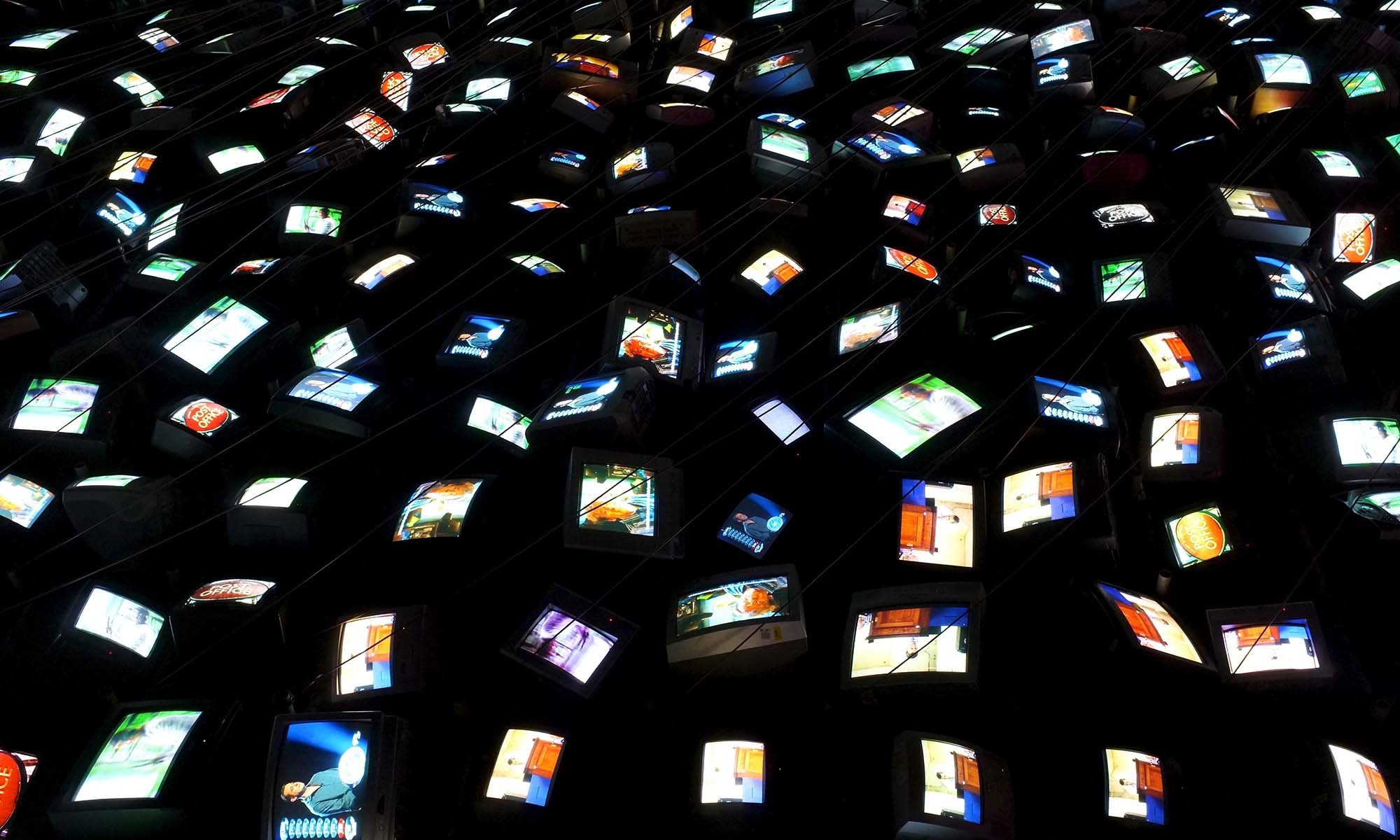RE_EXHIBIT 3
Shaping the Contemporary : Macedonian Video Art since 1984
Curated by Jon Blackwood
Featuring:
Dragan Abjanić, Iskra Dimitrova, Nora Stojanovikj, Vana Urošević, Elena Chemerska & Ivana Mirchevska.
15 February - 29 March 2024
This exhibition focuses on the development, discussion and production of moving image and video art in North Macedonia, since the late Yugoslav period.
Video art came relatively late to Macedonia, which was part of the former Yugoslav federation until independence in 1991. The first exhibition of video art, simply entitled VIDEO was held at the Museum of Contemporary Art in 1984, and grew out of an informal network of curators and television professionals based between Belgrade and Skopje. Television was particularly important, as one of the few places where equipment and necessary expertise could be found to make video art in the last years of socialism. Early video art was driven by two professionals working in television, Evgenija Dimitrievska and Katica Trajkovska, whilst one of the most prominent early exponents, Dragan Abjanić (1953-99) honed his skills as a video editor in his day job at Macedonian television.
Video in the 1990s fulfilled one of three broad functions; as documentation of performance (Iskra Dimitrova, Nora Stojanovikj), as space for the development of imaginative techniques or ideas (Vana Urošević), or as part of a multi-media installation. In this sense the canonical show IMAGE BOX organised by Nebojša Vilić under the auspices of the Soros Centre for Contemporary Art turbo-charged video production in the second half of the 1990s, not just through example but also by buying new equipment and making it available to those artists who wished to use it.
In addition to these pieces from the first decade of art production in the North Macedonian space, we are also delighted to present a contemporary moving image piece by Elena Chemerska and Ivana Mirchevska. Host or Parasite : Boiling Body (2023) discusses the impact on the individual of the intersection between planetary depletion and the last stages of neo-liberal capitalism.
Many of these videos are being shown for the first time in many years and are little known to audiences outwith the former Yugoslav space. This online exhibition is accompanied by a critical text from the curator, Jon Blackwood.
Acknowledgements: Jon would like to thank all the artists for permission to show their work as part of this exhibition, and for their enthusiastic response. Thank you to the family of Dragan, and to Vana, Iskra, Nora, Elena and Ivana. For help and discussion as the show was being prepared, I would like to thank Ena Abjanić Chausidis, Bojan Ivanov, Zoran Petrovski, Denis Saraginovski, Slobodanka Stevcheska, Evgenija Teodosievska, and Nebojša Vilić. Thanks to Laura Leuzzi and Adam Lockhart for their encouragement in supporting this work, and for the efforts to promote it and put it online
Cover Image: Elena Chemerska and Ivana Mirchevska – Host or Parasite : Boiling Body (2023)
Shaping the Contemporary : Macedonian Video Art since 1984
The story of video art in the Macedonian space straddles the many different social and political realities faced by the country and its citizens in the last forty years. It is a story that begins in late socialist Yugoslavia, the years of isolation, federal collapse and nation-building in the 1990s and 2000s, and the emergence, after the 2018 Prespa agreement, of “North Macedonia”, the country’s current official name.
The story of video art in North Macedonia is also little understood within the country, let alone beyond it. Beyond the small coterie of artists, historians, curators and art writers involved in the 1980s and 1990s, few remember the early origins of the medium, the founding exhibitions, or the alliances between television and visual art that provided the earliest works of video art in the country.
Whilst in the last twenty years a much clearer picture has emerged of the main contours of video art in late Yugoslavia, these efforts are focused in the centres where video began to be developed from the very late 1960s onwards- Ljubljana, Zagreb and Motovun in present day Croatia, and Belgrade. For different reasons, the early origins of video in the other ex-Yugoslav republics- Bosnia-Herzegovina, North Macedonia and Montenegro, remains little understood, and in danger of being forgotten entirely. Narrative accounts of modern and contemporary art in the former Yugoslav space concentrate overwhelmingly on Serbia, Croatia and Slovenia, leaving cultural ecologies at the Yugoslav periphery under-represented.
Video art had fifteen years’ of history in Yugoslavia, by the time of the first ever video art manifestation at the Museum of Contemporary Art in Skopje, in November 1984. There is no photographic record of the event which Zoran Petrovski, one of the co-organisers of the event, attributes to its rather informal nature.
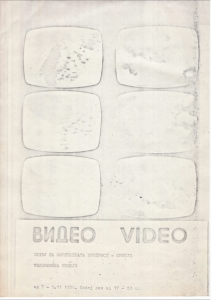
The event brought together many of the well-established names from Yugoslav video of the time, with Biljana Tomić, the director of the art programme of the Students’ Cultural Centre (SKC), and Dunja Blažević, presenter of TV Galerija and Petkom u 22 on Yugoslav TV, acting as co-curators alongside Petrovski who spent a whole career working in various roles at the Museum of Contemporary Art. An array of contemporary art and television organisations from across Yugoslavia were organised in logistical and technical support for what sounds to have been an intense weekend of lectures, discussions, and showings of video art from the established names of the medium at that time, in the Yugoslav context. Amongst the works considered were Marina Abramović & Ulay’s Imponderabilia (1977), alongside early pieces by artists such as Goran Trbuljak, Dalibor Martinis, Neša Paripović, and Radomir Damnjanović-Damnjan.
Alongside these works were a selection of documentary films chosen by TV Skopje from Macedonian authors, and a selection of American video art from the 1970s put together by the American Cultural Information Centre.
This significant early event linked the socialist Macedonian space to the maturing conversations on video art elsewhere in the Yugoslav federation. The infrastructure and conditions for the production of video art at this time were not terribly easy. Socialist Yugoslavia endured a systemic economic crisis in the later 1980s and consumer goods such as the camcorders increasingly available in Western Europe, were simply unavailable to most. Making video art in the Macedonian context required access to institutions with equipment and skills. In almost all cases, this was the local television station- Makedonska Televizija, the official state channel for the republic. The relationship with television and a few visionary and ambitious programmers in the 1980s was of critical importance to the development of video art and indeed a sense of contemporary art practice across the Yugoslav population. Dunja Blažević’s pioneering television work was of the utmost significance in this regard.
Video art raised its profile incrementally in late socialist Macedonia. Thanks to the French Cultural Centre, an exchange was established with Montbeliard, which saw a major showing of international video practice at the Museum of Contemporary Art in 1985, and again in 1986. “Film”, through early directors such as Mitko Panov, began to appear in the Biennial of Young Artists held by the Museum, with Panov showing two films in 1987. Early attempts to build an infrastructure for video art in Macedonia stressed the inter-relation of video art with television and the lines between the two were very blurred. In an essay for the Montbeliard catalogue of 1986, an anonymous writer chews the problem over:
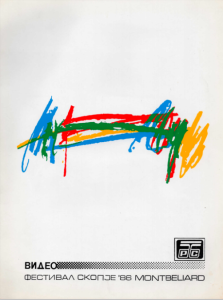
“The relationship between television and video art is particularly ambiguous…Ever since artists began working in video…they suddenly found themselves as the single voice or vision in the middle of the mass media’s culture. Although they were using television, they were not making television, they were making art. And to read the broad audience of television, how were they to keep this message of individuality intact and undiluted?
Television was faced with a different dilemma, but just as problematic. For them, the question was: did the benefit of the artist’s vision justify the potential economic risks?”
Beyond these early discussions and experiments, video art was established just as much by Macedonian and Skopje TV as by curators and artists. The key figures in the late 1980s were the television professionals Evgenija Dimitrievska and Katica Trajkovska (Trajkovska together with Dragan Abjanić straddled the worlds of television and Fine Art, acting professionally in both domains). Dimitrijevska and Trajkovska were in charge of the cultural programme of Skopje television in the second half of the 1980s and joined forces to organise “colonies” to focus on video art making and production, firstly in Ohrid in 1989 and then again in Skopje in 1992.
The ”colony” is a long-established cultural manifestation that still persists in the post-Yugoslav space. It can be understood in English as a retreat, where the state pays for artists to gather in a different place to discuss and produce art. Traditionally, the “colony” implies activities of painting and drawing, but in this case the form was turned to gather together local artists interested in video to learn not only techniques but also from prominent exponents of video art from outside Yugoslavia / Macedonia.
Ohrid’89 lasted for fifteen days in total and the works presented included video by Britain’s Jeremy Welsh and France’s Jean-Louis Le Takon, and artists from elsewhere in Yugoslavia including Nuša Dragan, Marina Gržinic and Ana Smid (Slovenia), Narčis Kantardžic (Bosnia-Herzegovina) and Croatia’s Breda Beban and Hrvoje Horvatić. Although the straitened economic circumstances of a newly independent Macedonia in 1992 reduced the number of international visitors, the colony was able to interact with Germany’s Christoph Dering, Switzerland’s Eva Kroft and Bosnia’s Anis Bajraktarević.
The works made as a result of these colonies, and the steady growth of a group of Macedonian artists engaged in video, began to see these works shown elsewhere in Yugoslavia and later in venues around the world. Our first video, in chronological terms, Ana, by Dragan Abjanić and Ivan Cunihin, featuring Vana Urošević, was shown in 1988 in Sarajevo, Zagreb and Belgrade and later travelled to a video art festival in Osnabrück. By 1995, Abjanić was winning international prizes for his work, being awarded a prize by the European parliament in that year for his film Danach.
The Macedonian state voted for independence on 8 September 1991, leaving behind the increasingly troubled and dwindling Yugoslav federation, months away from the catastrophic wars in Bosnia and Croatia from April 1992. Inevitably, any momentum behind video art had to be developed more by television in these first few years of independence, as cultural institutions saw generous budgets all but disappear in conditions of post-socialist transition. Much of Abjanić’s career was underpinned by his work for Skopje TV and later, the new private channel A1, founded in January 1993.
However other actors and motors of development emerged for video art in the 1990s. Key amongst these was the Soros Centre for Contemporary Art in 1994, under the aegis of art historian and curator Nebojša Vilić. Vilić curated one of the most important shows featuring video in Macedonian art history- Image Box, featuring seventeen artists and held at Mala Stanica, a space owned by the National gallery of Macedonia in Skopje. The show was significant for three reasons. Firstly, it sought programmatically to liberate video art from its previous dependence on television both in terms of infrastructure and creative ambition. This was a show of video installation as art, rather than just video art on televisions. Vilić wanted the artists involved to use video as a means for artist to develop ideas and the ‘poetics of their expression’ without paying heed to the conventions of television. Perhaps most importantly, he invested significantly in new equipment- both televisions and cameras- which enabled professional artists to borrow this equipment to make projects without necessarily needing connections with state television.
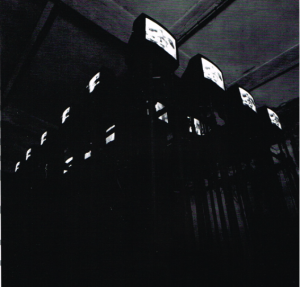
The impact of these ambitious underpinnings can clearly be seen in Iskra Dimitrova’s video in our selection for this exhibition, Magna Mater Deorum, which was produced for the Image Box show. The work focuses closely on ritual, feminity, and imaginative transformation of materials.
The exhibition also featured talks from invited international guests on video art and visual culture. The exhibition featured almost all of the artists who had experimented with video as part of their practice in the first decade of Macedonian video art whom we have not been able to include in our brief snapshot here- notably, Aleksandar Stankovski, Venko Svetkov, whose solo retrospective will open soon in the National Gallery of Macedonia, Igor Toševski and Žaneta Vangeli.
The shift from early to resolved video production in the Macedonian context can be seen in the work of Vana Urošević. Here involvement in Abjanić / Cunihin’s Ana of 1987 is in her presence throughout the video; a darkly Gothic, indeterminate space drawing in quotations, editing techniques and allusions from film directors such as Stanley Kubrick, David Lynch, Andrei Tarkovsky, with even perhaps a nod to Juraj Herz’s Czech horror film Morgiana (1972). Urošević, who was perhaps better known as a painter of uncanny interiors and still-lives, beautiful clothes and unusual domestic trinkets and jewellery, seems to inhabit one of her own two dimensional works in this piece, a liminal space where time, identity and self-awareness all seem to be in a vertiginous flux. Our discomfort is shaped and honed by Abjanić’s remarkable editing skills.
Vana’s later work, Meluzine, was produced in 1998-99 and relates programmatically to an earlier installation Hemming Glass Fragments, shown at Daut Pasha Hammam in Skopje. Meluzina features a sculptural object made from that exhibition, and the artist’s performance with it. At that time, she kept silk worms at home, and her work focused in part on the form of the silkworms in their cruel fate; one metre of silk can only be produced through the death of one thousand silk worms. In so doing, the artist drew attention to the complex relationship between beauty, creativity and death, and saw this video piece as an integral part of the body of work addressing these issues. The artist’s only frustration was the difficulty sometimes in finding a video editor to work with and in so doing having to make certain compromises with that editor in order to realise the final work.
In addition to offering the possibility to engage with televisual forms and production in its early years, and moving on towards seeing video as a medium where ideas could be developed in consort with other visual art media, video was also used as documentation of performance. The example in our selection is Nora Stojanovikj;s Gathering Scales of the Big Fish (1997), a performance in Skopje’s central shopping mall (today known as GTC Shopping City).
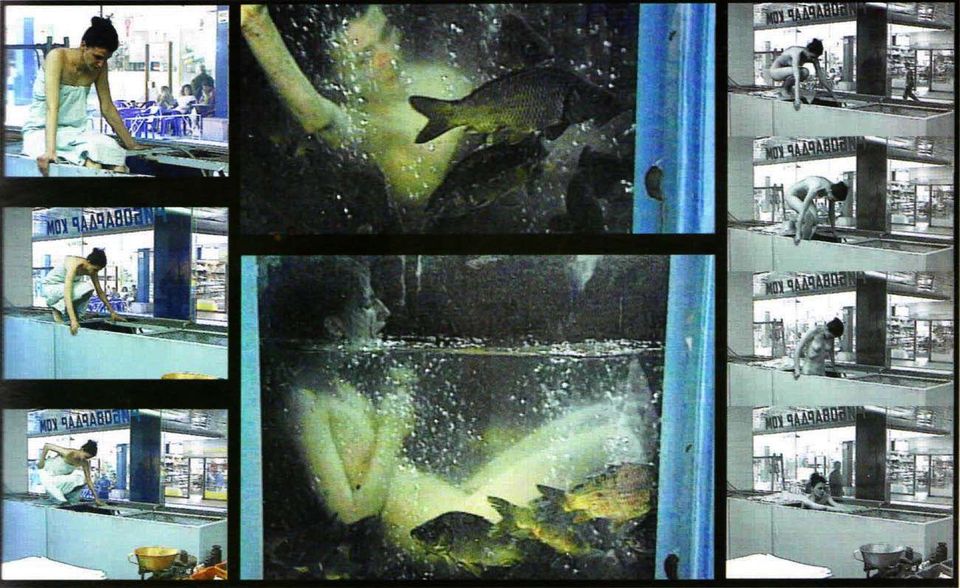
This performance was part of an international exchange of women artists entitled Liqor Amnii curated by Suzana Milevska and her American counterpart Sheila Pepe. In a fishmonger’s in the basement, Stojanovikj, surrounded by an almost entirely male audience, disrobes and immerses herself in a tank full of fish for sale, commenting on inter-species relationships (the piece derived in part for her sympathy at fish having to spend their last days in an overly-crowded tank) as well as a feel of feeling crowded out, judged and observed as a young woman in a strongly patriarchal society. The courage in Stojanovikj’s public intervention- something that would be difficult even in our time- and the challenge to an ongoing patriarchal societal organisation are issues that still resonate strongly.
This brief introduction can only give a surface impression of the main events of the first fifteen years of video art in the Macedonian space. I thought it important to include, in conclusion, a contemporary moving image work from our time. This is a collaborative piece by Elena Chemerska and Ivana Mirchevska who have been working across a hybrid practice of moving image and performance for some time now.
Strongly influenced by visual anthropology and the ideas of xenofeminism and the implications of the post-digital, this is a work which is darkly humorous on two of the key anxieties underpinning the current systemic polycrisis; individual burnout through overwork and overproduction in late capitalism, and a concomitant species depradation. However different and perhaps less optimistic the time that these young artists are developing in, the role that video plays has changed little from the 1980s and the 1990s. On the one hand, economics and infrastructure means that no artist can make money alone from a moving image practice; instead, video and moving image tend to form an important part of a multi-disciplinary practice, in the Macedonian context.
There would be much more to say on the development of video art in Macedonia in the first quarter century of our time, but it will have to wait for a longer form essay and hopefully a wider presentation of the work in other formats and on other platforms on and offline in the near future. I hope you have enjoyed this insight into Macedonian video art and that it sharpens your interest in finding out more.
Jon Blackwood
Aberdeen
15 February 2024

Jon Blackwood’s work focuses on the intersections between contemporary art and radical politics, and cultural ecologies, in the post-Yugoslav space. He is the author of Critical Art in Contemporary Macedonia (Skopje : mala galerija, 2016) and curated shows of Macedonian art including Captured State : New Art from Macedonia (Summerhall, Edinburgh, 2017) and In Between States (Peacock, Aberdeen and Museum of the City of Skopje, 2019). Previous video shows include Imaginarium : Contemporary Video Art from Macedonia (Aberdeen, 2016) and Late to the Party : Macedonian Video Art since 1991 (part of PANCH / BANG BANG Festival, Basel, Switzerland, 2022). Jon is Associate Professor of Contemporary Art at Gray’s School of Art, RGU, Aberdeen, and is based between Aberdeen, Sarajevo and Skopje.
Dragan Abjanić (1953-99) Educated at the Faculty of Philosophy in Skopje. Worked towards video art production through his work as a video editor for state and private TV companies (Macedonian TV, TV Skopje, A1 TV). Winner of a European Parliament prize for Video Art, 1995. His work was exhibited throughout the former Yugoslavia and across Europe from the late 1980s to the middle 1990s.
Iskra Dimitrova (b. 1965) Educated in Skopje both at the Faculties of Philosophy and Fine Art. Previous work in performance, video and installation with a feminist focus. Exhibited widely internationally, in Scotland, England, Croatia, France, Germany, Greece, Japan, Serbia, Slovenia, South Korea, and the United States. Represented Macedonia at the 1999 Venice Biennale. Lives and works in Skopje.
Nora Stojanovikj (b. 1967) was educated in Skopje, and was involved in music as much as contemporary art for some years in the 1990s. She was best known as a singer in the Macedonian band Mizar. With Zlatko Trajkovski, she founded a multi-media art group Vermillion Deviate. Has exhibited in Macedonia, the United States, and Slovakia. Since the 1990s she has worked in many different activist fields focusing, variously, on harm reduction from drug use, and sex workers’ rights, whilst maintaining a strong interest in contemporary music and culture. She lives and works in Skopje.
Vana Urošević (b. 1961) Educated in Belgrade. Multi-disciplinary artist working in painting, performance, and video. Previous shows in Belgrade, Zagreb, Ljubljana, Sarajevo, Novi Sad, Osnabrück, Hamburg, and many other venues nationally, regionally, and internationally. Represented Macedonia at the 2004 Venice Biennale. Currently lives and works in Skopje.
Elena Chemerska (b. 1991) Educated in Skopje and s’ Hertogenbosch, Netherlands. Winner of the 2021 DENES award for young Macedonian artists. Multi-disciplinary artist in video, performance, public installation and painting. Solo and group exhibitions in North Macedonia, Slovenia, the Netherlands, Germany, Italy, Scotland and the United States. Lives and works between Skopje and Berlin.
Ivana Mirchevska (b. 1992) Educated in Skopje and Milan. Winner of the 2022 DENES award for young Macedonian artists. Multi-disciplinary practice focused on moving image and visual anthropology. Lives and works between Italy and Skopje.
